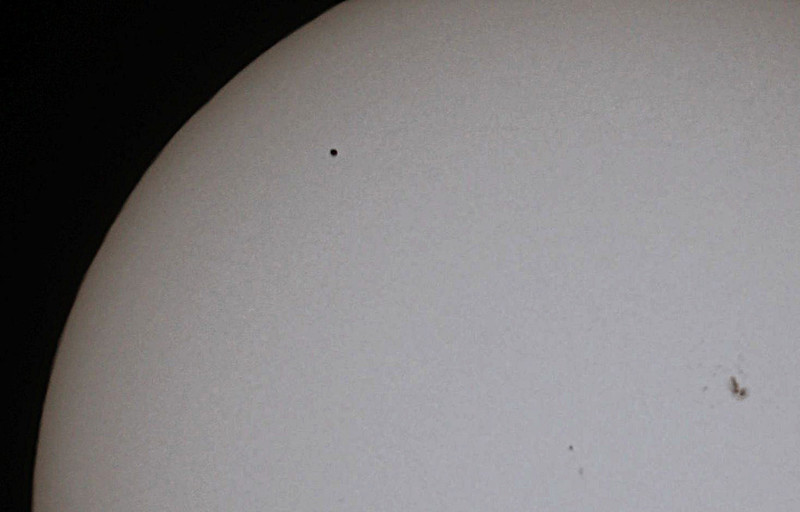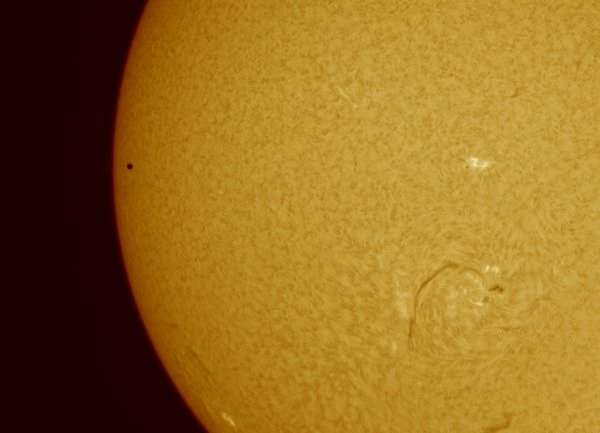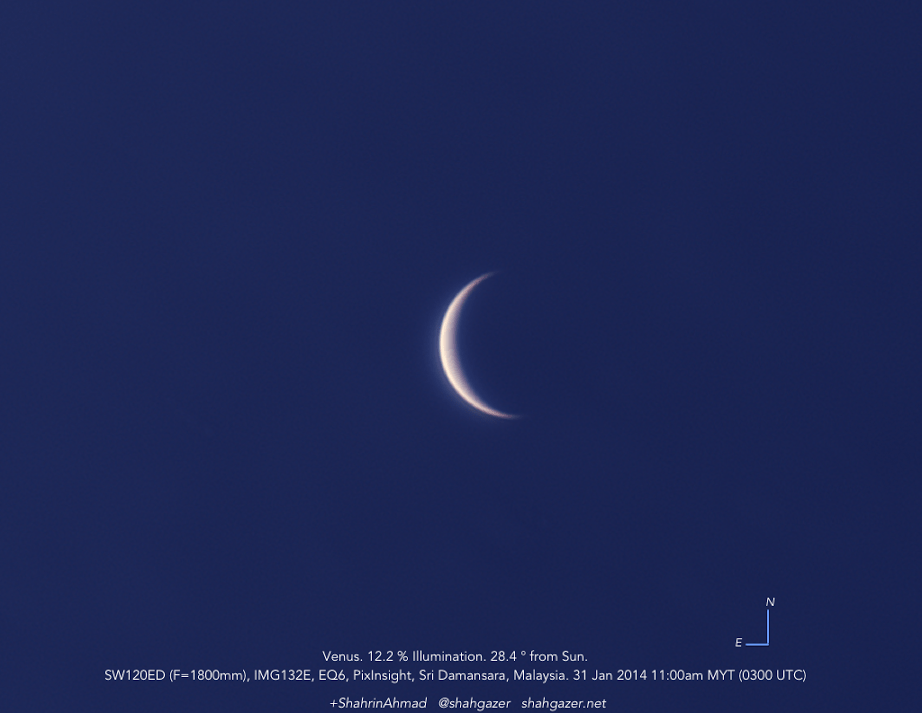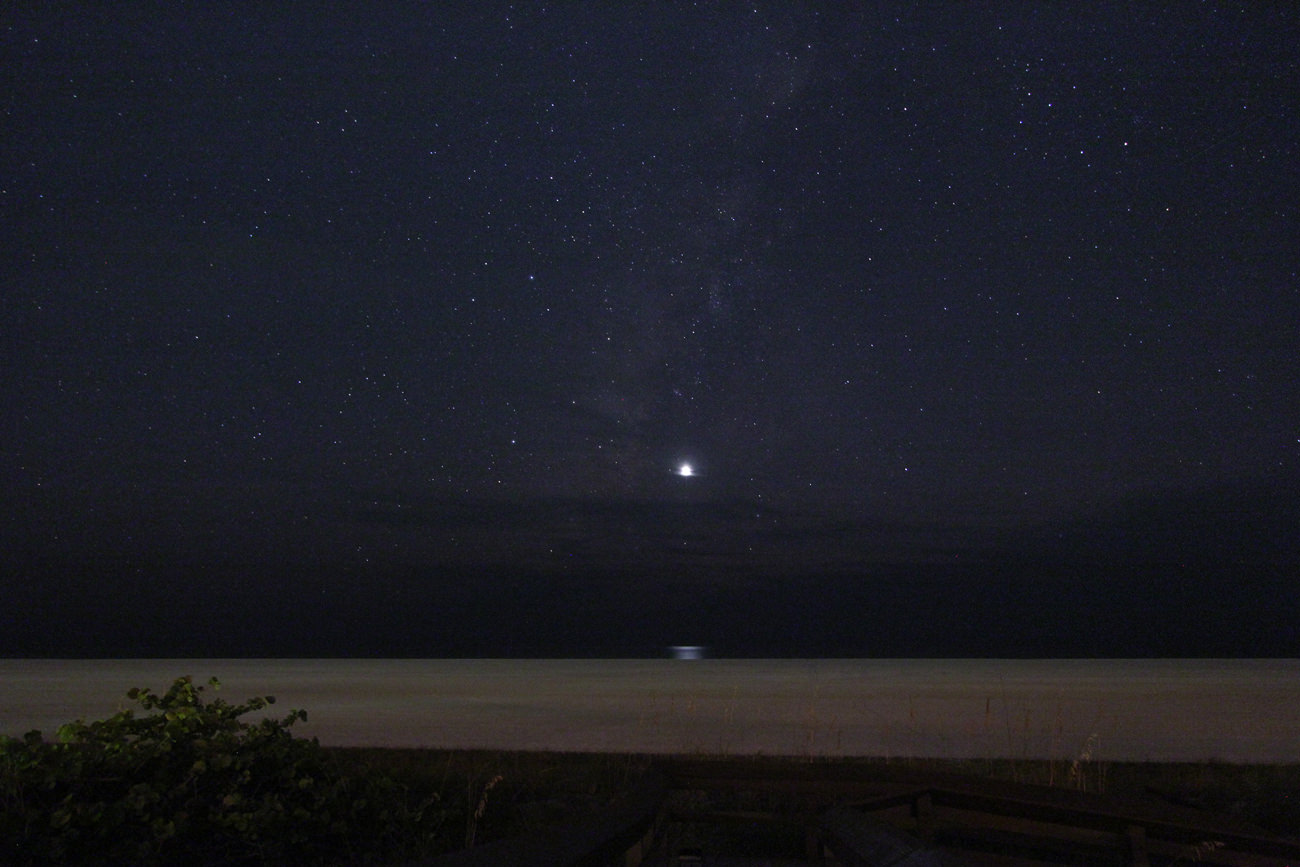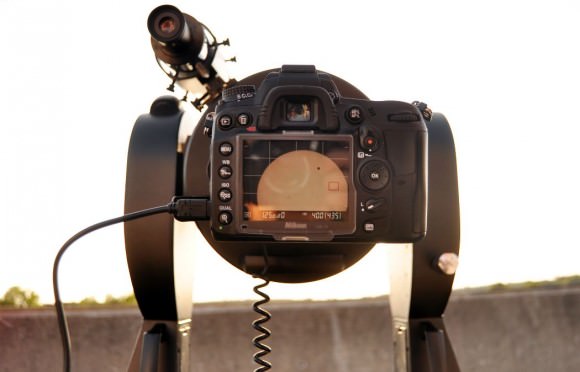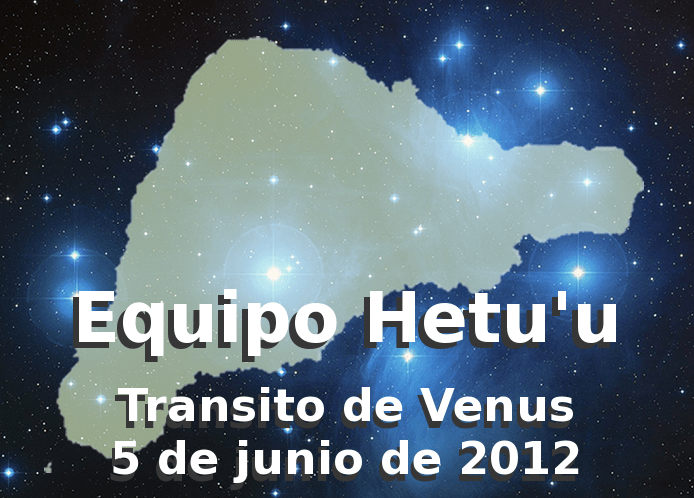One of the finest spectacles in astronomy is to witness the passage of one object in front of another. This can transpire as an eclipse, an occultation, or a rare event known as a planetary transit. We get a shot at seeing just such a singular event next Monday on November 11th, as a transit of Mercury across the face of Sol occurs for the last time this decade.
Continue reading “Our Guide to the November 11th, 2019 Transit of Mercury Across the Sun”What Are Planetary Transits?
Thanks to Ptolemy and his cronies, everyone used to think that the Earth was the center of the Solar System, with the Sun, planets and even the stars orbiting around it on a series of concentric crystal spheres. It was a clever idea, and explained the motions of the planets… sort of.
Then Copernicus figured out in 1543, that the Earth isn’t the centre of the Solar System. In fact, it’s just one planet in a vast Solar System, with objects whirling and whirling around the Sun.
With the structure of the Solar System figured out, and the crystal sphere idea in the garbage, astronomers still had a big unknown: how big is the Solar System?
Was it a few million kilometers across, or hundreds of millions. How big is the Sun? How far away is Venus?
Astronomers needed some kind of cosmic yardstick to measure everything against. Figure out one piece of the puzzle, and then you could measure everything else in relation.
In 1627, Johannes Kepler figured out that the motion of Venus was predictable, and that Venus would pass in front of the Sun in 1631, probably in the afternoon.
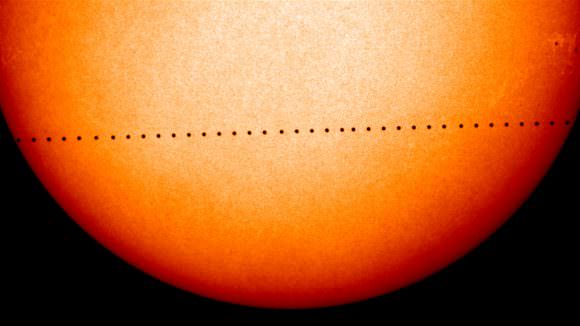
This is known as a “transit” of Venus.
The first crude measurements of Venus’ motion across the Sun were made in 1639 by Jeremiah Horrocks and William Crabtree from two different spots in England. And with these two observations, they were able to calculate the geometry between the Earth, Venus and the Sun.
If you recall all those memories you’re repressing from your high school geometry, once you’ve got an angle and a side of a triangle, you can work out all the other parts of the triangle. Horrocks and Crabtree worked out the distance from the Earth to the Sun within about 2/3rd accuracy. Not bad, considering the fact that astronomers literally had no idea before this point.
Following on from this observation, astronomers returned to their telescopes with each transit of Venus, better refining their calculations, and eventually settling on the current distance of about 150 million kilometers.
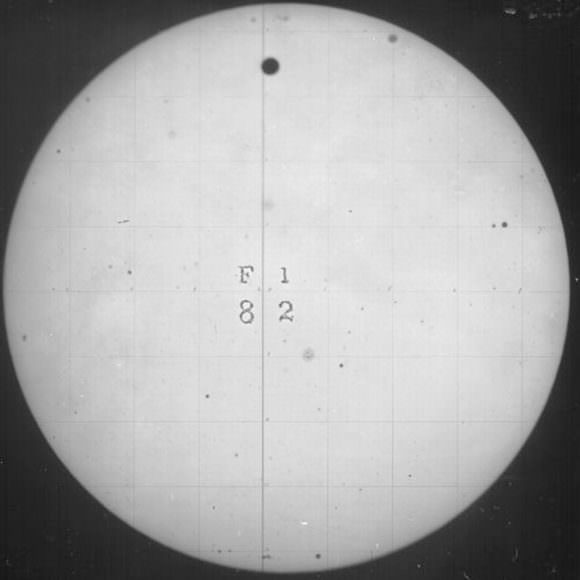
From here on Earth, we can see a few objects pass in front of the Sun: Venus, Mercury and the Moon.
Venus transits are the most rare, happening two times every 108 years or so. Mercury transits happen more often, about a dozen times a century. And a transit of the Moon, also known as a solar eclipse, happens a few times a year, on average.
It’s all a matter of perspective. If you’re standing on the Moon, you might see the Earth pass in front of the Sun. We’d call that a lunar eclipse, while the lunatics would call it an Earth transit.
We can also see transits in other parts of the Solar System, like when moons pass in front of planets. For example, if you have a small telescope, you can see when Jupiter’s larger moons pass in front of the planet from our perspective.
One of the questions you might have, though, is why don’t these transits happen more often. Why don’t we see a Mercury or Venus transit every time they line up with us and the Sun.
This is because the planets aren’t exactly lined up at the same angle towards the Sun. All of the planets are inclined at an angle that takes them above or below the Sun at various points of their orbit.
For example, Venus’ orbit is inclined 3 degrees off the Sun’s equator, while the Earth is inclined 7 degrees. This means that most of the time that Venus and Earth are lined up, Venus is either above or below the Sun.
Are you an ageless vampire, or planning to live a long time in multiple robot bodies, then you’re in luck. In the year 69,163, there’ll be a double transit on the surface of Sun with both Mercury and Venus at the same time. Enjoy that while you contemplate the horror of your existence.
Once we become a true Solar System civilization, there will be even more opportunities for transits. People living on Mars will be able to see Mercury, Venus and even transits of Earth passing in front of the Sun. Neptunians will be bored they can see them so often.
The transit method is one of the ways that astronomers discover planets orbiting other stars. Using a space telescope like Kepler, they survey a portion of the night sky, watching the brightness of thousands of stars. When a planet perfectly passes directly in between us and a star, Kepler detects a drop in brightness.
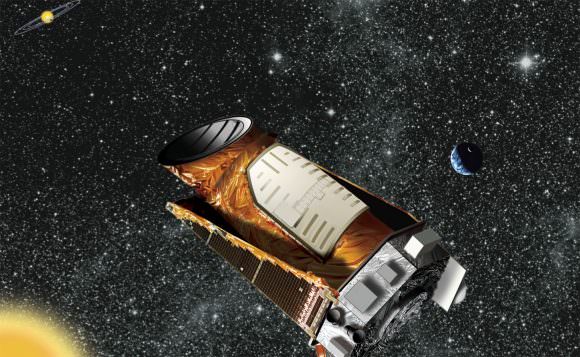
When you think of the geometries involved, it’s amazing this even happens at all. But the Universe is a vast place. Even if only a tiny percentage of star systems are perfectly lined up with us, there are enough to help us discover thousands and thousands of planets.
Kepler has turned up Earth-sized worlds orbiting other stars, some of which are even orbiting in their planet’s habitable zone.
Watching planetary transits is more than just a fun astronomy event, they’re how astronomers figured out the size of the Solar System itself. And now they help us find other planets orbiting other stars.
So, let’s agree to meet up in 2117 to catch the next transit of Venus, and celebrate this amazing event.
Images of Today’s Transit of Mercury From Around the World
Lead image credit: Brendan Martin.
(Note: Awesome images are being added as they come in!)
Update: Here’s two more amazing videos of yesterday’s transit of Mercury that have come our way. First: double solar transits featuring Mercury, the International Space Station and a low flying plane right here in the skies of good old planet Earth courtesy of (who else?) Thierry Legault:
And here’s one of the very few sequences we’ve seen of the transit with foreground, captured at sunset by Gadi Eidelheit based in Israel:
And finally, check out this amazing (and mesmerizing) animation of Mercury racing across the Sun, courtesy of the Big Bear Solar Observatory!
It’s not every day you get to see a planet pass in front of the Sun.
But today, skywatchers worldwide got to see just that, as diminutive Mercury passed in front of the disk of the Sun as seen from the Earth. This was the first transit of Mercury across the face of the Sun since November 8th, 2006, and the last one until November 11th, 2019. Continue reading “Images of Today’s Transit of Mercury From Around the World”
Watch Venus as it Wanders Through the Dawn in 2014
Are you a chronic early riser? Observational astronomy often means late nights and early mornings as daylight lengths get longer for northern hemisphere residents in February through March. But this year offers another delight for the early morning crowd, as the Venus is hanging out in the dawn skies for most of 2014.
You may have already caught sight of the brilliant world: it’s hard to miss, currently shinning at a dazzling -4.5 magnitude in the dawn. Venus is the brightest planet as seen from Earth and the third brightest natural object in the night sky after the Sun and the Moon.
Venus just passed between the Earth and the Sun last month on January 11th at inferior conjunction. Passing over five degrees north of the Sun, this was a far cry from the historic 2012 transit of the solar disk, a feat that won’t be replicated again until 2117 AD.
But February and March offer some notable events worth watching out for as Venus wanders in the dawn.
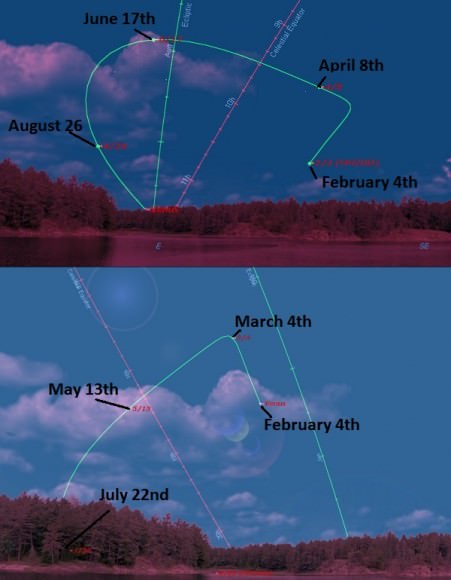
This week sees Venus thicken as a 48” 16% illuminated waxing crescent as it continues to present more of its daytime side to the Earth. We’ve always thought that it was a bit of cosmic irony that the closest planet too us presents no surface detail to observers: Venus is a cosmic tease. This assured that astronomers knew almost nothing about Venus until the dawn of the Space Age — guesses at its rotational speed and surface conditions were all widely speculative. Ideas of a vast extraterrestrial jungle or surface-spanning seas of seltzer water oceans gave way to the reality of a shrouded hellish inferno with noontime temps approaching 460 degrees Celsius. Venus is also bizarre in the fact that it rotates once every 243 Earth days, which is longer than its 224.7 day year — you could easily out walk a Venusian sunrise, that is if you could somehow survive to see it from its perpetually clouded surface!
Venus also passes 4.3 degrees from faint Pluto this week on February 5th. And while Pluto is a tough catch at over a million times fainter than Venus, it’s interesting to consider that NASA’s New Horizons and ESA’s Rosetta spacecraft are also currently off in the same general direction:
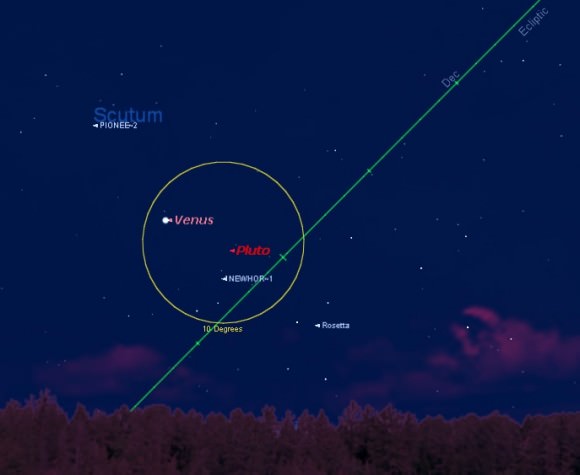
Venus also reaches greatest brilliancy at magnitude -4.6 next week on February 11th. Venus is bright enough to cast a shadow onto a high contrast background, such as freshly fallen snow. Can you see your “Venusian shadow” with the naked eye? How about photographically?
Venus then goes on to show its greatest illuminated extent to us on February 15th. This combination occurs because although the crescent of Venus is fattening, the apparent size of the disk is shrinking as the planet pulls away from us in its speedy interior orbit. Can you spy the elusive “ashen light of Venus” through a telescope? Long a controversy, this has been reported by observers as a dim “glow” on the nighttime hemisphere of Venus. Proposed explanations for the ashen light of Venus over the years have been airglow, aurorae, lightning, Venusian land clearing activity (!) or, more likely, an optical illusion.
And speaking of which, the crescent Venus gets occulted by the waning crescent Moon on February 26th. Observers in western Africa will see this occur in the predawn skies, and the rest of us will see a close pass of the pair worldwide. Can you spot Venus near the crescent Moon in the daytime sky on the 26th?
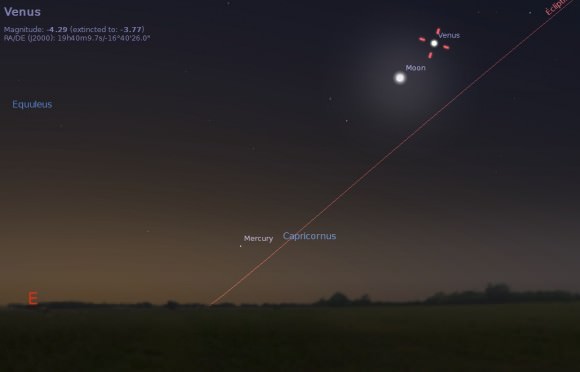
In March, Venus begins the slide southward towards the point occupied by the Sun months earlier and heads towards its greatest westward elongation for 2014 on March 22nd at 46.6 degrees west of the Sun. Interestingly, Venus is tracing out roughly the same track it took 8 years ago in 2006 and will trace again in 2022, when it will also spend a majority of the year in the dawn once again. The 8-year repeating cycle of Venus is a result of the planet completing very nearly 13 orbits of the Sun to our 8. Ancient cultures, including the Maya, Egyptians, and Babylonian astronomers all knew of this period.
Through the telescope, Venus appears at a tiny “half-moon” phase 50% illuminated at greatest elongation, a point known as dichotomy. It’s interesting to note that theoretical and observed dichotomy can actually vary by several days surrounding greatest elongation. An optical phenomenon, or a true observational occurrence? When do you judge that dichotomy occurs in 2014?
In April, one of the closest planetary conjunctions occurs of 2014 on the 12th involving Neptune and Venus at just 40’ apart, a little over the span of a Full Moon. Can you squeeze both into an eyepiece field of view? At +7.7th magnitude, Neptune shines at over 25,000 times fainter than Venus. Neith, the spurious “moon” of Venus described by 18th century astronomers lives!
But two even more dramatic conjunctions occur late in the summer, when Jupiter passes just 15’ from Venus on August 18th and Regulus stands just 42’ from Venus on September 5th. Fun fact: Venus actually occulted Regulus last century on July 7th, 1959!
From there on out, Venus heads toward superior conjunction on the far side of the Sun on October 25th, to once again emerge into the dusk sky through late 2014 and 2015.
Be sure to check out these dawn exploits of Venus through this Spring season and beyond!
Bright Venus Takes Center Stage in November
“What’s that bright object to the southwest at dusk?” We’ve already fielded more than a few such questions as Earth’s sister world shines in the dusk sky. Venus just passed its maximum elongation 47 degrees east of the Sun on November 1st, and currently shines at a brilliant magnitude -4.46. This is almost 16 times brighter than the brightest star in the sky, -1.46th magnitude Sirius.
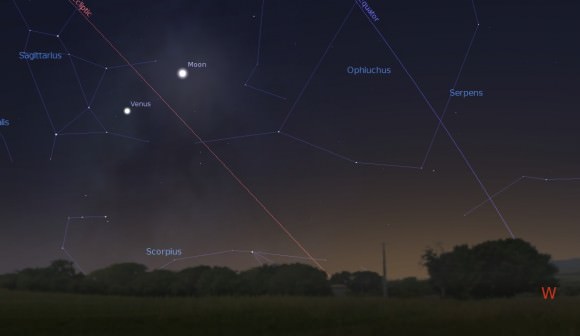
Just like the Moon, Venus goes through a full range of phases. Through the telescope, Venus currently presents a 26.7” diameter disk. That size will swell to almost 40” by month’s end, as Venus begins to approach the Earth and presents a noticeable crescent phase. We just passed dichotomy — the theoretical point where Venus presents a half-illuminated phase as seen from Earth — on October 31st, and Venus already shows a noticeable crescent:
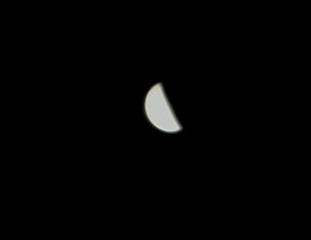
Note that we say “theoretical” because there’s typically a discrepancy of a day or two between predicted and observed dichotomy. This is also known as Schröter’s Effect. One probable cause for this is the dazzling appearance of the disk of Venus. We typically use a variable polarizing filter to cut the glare of Venus down at the eyepiece.
You might also note that Venus currently occupies the “basement” of the zodiac in the constellation Sagittarius. In fact, the planet is currently as far south as it can go, sitting at a declination of -27° 14’ on this very evening. You have to go all the way back to 1930 to find a more southerly declination of Venus, just 12’ lower!
But you won’t have to wait much longer to break that record, as the chart below shows for the most southerly declinations of Venus for the next half century:
| Year | Date | Declination |
| 2013 | November 6th | -27° 09’ |
| 2021 | “ “ | -27° 14’ |
| 2029 | “ “ | -27° 18’ |
| 2037 | “ “ | -27° 23’ |
| 2045 | “ “ | -27° 29’ |
| 2053 | “ “ | -27° 34’ |
| 2061 | “ “ | -27° 39’ |
Note that each event occurs on November 6th, and they’re spaced 8 years apart. Apparitions of Venus closely duplicate their paths in the sky over an 8 year cycle. This is because the planet nearly completes 13 orbits of the Sun for our 8. Venus “catches up” to the Earth on its interior orbit once every 584 days to reach inferior conjunction. It usually passes above or below the Sun from our vantage point, though last year it transited, a feat that won’t be witnessed again until 2117 AD.
How far south can Venus go? Well, its orbit is tilted 3.4 degrees relative to the ecliptic. It can reach a southern declination of -28 05’, though you have to go way back to 1874 for its last occurrence!
Today is also a great time to try your hand at spotting Venus in the daytime, as a 3-day old waxing crescent Moon lies about eight degrees to its upper right:
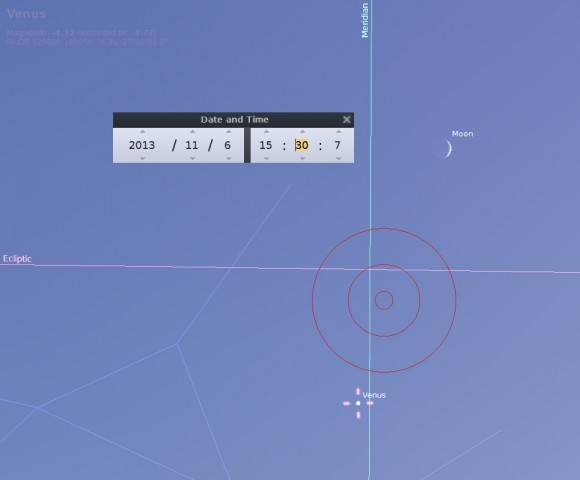
Note that seeing Venus in the daytime is surprisingly easy, once you known exactly where to look for it. Your best chances are around mid-afternoon at about 3PM local, when the daytime Moon and Venus lie highest in the southern sky. Did you know that Venus is actually intrinsically brighter per square arc second than the Moon? It’s true! The Moon actually has a very low reflective albedo of 12% — about the equivalent of fresh asphalt — while the cloud tops of Venus are more akin the fresh snow with an albedo of about 80%.
Its also worth checking out Venus and its local environs after nightfall as it passes near the Lagoon (M8) and the Trifid nebula (M8) on the night of November 6th. Continuing with its trek across the star rich plane of the heart of the Milky Way galaxy, Venus also passes near the globular cluster M22 on November 13th.
Venus also sits in the general of Pluto on November 15th, lying just 6.6 degrees south of it. Be sure to wave in the general direction of NASA’s New Horizons spacecraft bound for Pluto in July 2015 tonight as well, using the Moon and Venus for a guide:
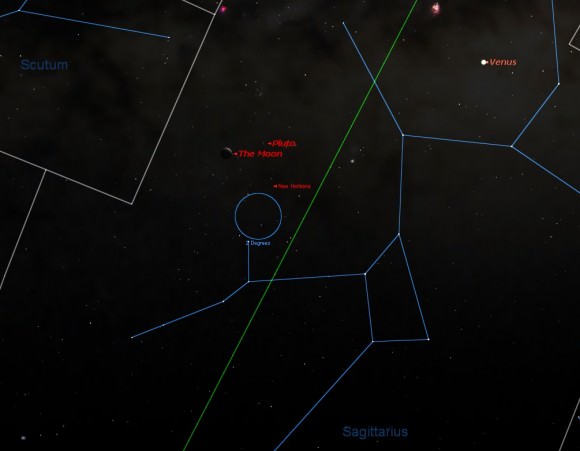
Another shot at seeing Venus paired with the Moon occurs on December 5th.
Venus also presents a maximum area of illumination on December 6th, and will shine at its brightest on December 10th at magnitude -4.7. Can you catch it casting a shadow? The best time to search for this illusive phenomenon would be just before New Moon on December 2nd. A dark sky site away from any other sources of illumination, and a snow covered ground providing high contrast also helps. Fortunately, snow isn’t in short supply in the northern hemisphere in December!
Venus is currently the only naked eye planet in the November early evening sky. We always thought that it’s a bit of a cosmic irony that the nearest planet presents a dazzling, but featureless white disk as seen from Earth. Diligent amateurs have, however, been able to tease out cloud patterns on Venus using UV filters.
Another elusive phenomenon to watch for as Venus reaches a crescent phase is ashen light. Long reported by observers, a faint glow on the night side of Venus is something that persists, but shouldn’t be. A similar effect seen on the night side of the Moon known as Earthshine is easily explained by sunlight being reflected off of the Earth… but Venus has no moon. What gives? Frequent explanations over the years have been aurorae, electrical activity, airglow, or, more frequently cited, observer bias. The brain wants to see a filled in space, and promptly inserts it betwixt the dazzling horns of the planet.
Keep an eye on Venus as it reaches maximum brilliancy and heads towards inferior conjunction on January 11th, 2014, and a rare chance to see it on said date… more to come!
Weekly Space Hangout – June 7, 2012
In this week’s episode of the Weekly Space Hangout, Universe Today’s Fraser Cain is joined by Alan Boyle from MSNBC and Amy Shira Teitel from Vintage Space.
They discussed:
- The 2012 Transit of Venus
- The space shuttle Enterprise’s final journey to a museum.
- NASA’s new plans for commercializing space
- A quick review of the new movie Prometheus
We record the Weekly Space Hangout live every Thursday at 10 am Pacific/ 1 pm Eastern. Watch us record the show live on Google+ every week. The show is also broadcast live over on Cosmoquest.
Amazing Transit of Venus Images From Around the World
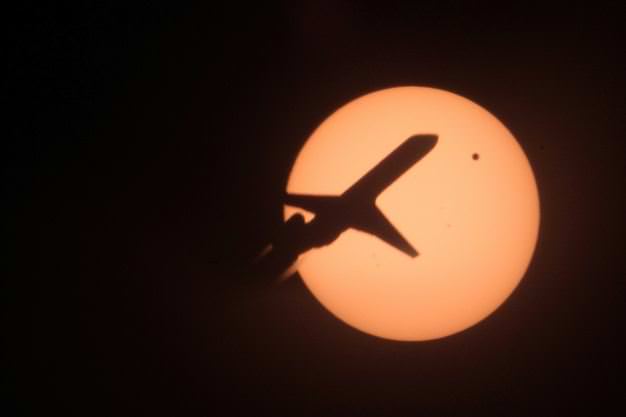
Wow! Amateur astronomers around the world looked to the sky last night and early this morning to observe Venus as it passed across the face of the Sun for the last time this century. The images are coming in fast and furious from what was an awesome event! Our lead image is from Jim Nista in Huntington Beach, California who said on Flickr, “Saw the contrails approaching the Sun’s disk and starting snapping as fast as the Canon 7D could go!”
See more below from all around the world, and also check out some of the first images and videos from last night. You can also watch a replay of our live webcast here. For many of the images from Flickr, click on the images for a higher resolution view.
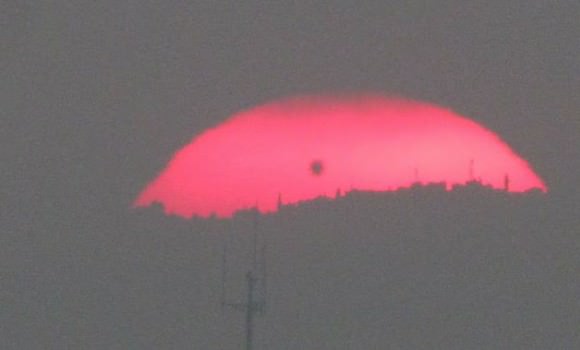
Our friend Gadi Eidelheit from Israel hosted a transit event, taking this sci-fi- looking image, and many more. He has a full write-up on his Venus Transit blog.
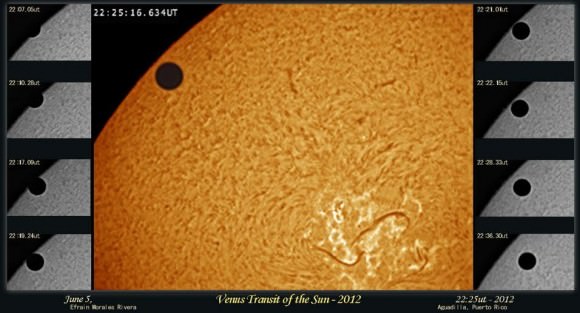
This composite of a sequence of images are from Efrain Morales in Puerto Rico. “Clouds moved out and but the Sahara dust still lingered,” Efrain told Universe Today. “Started my sequence on 22:07ut thru 22:36ut. It was a Spectacular sight.” Equipment: SolarMax40 Refractor, PowerMate 2.5x barlows, P/B LX200ACF 12 in. OTA, CGE mount, PGR Flea3 Ccd, Astronomik Ir filter.
Kaizad Viraf Raimalwala from the Purdue University Astronomy Club in Indiana sent in this image: “In this picture, we were using an 8″ Meade LX-200 and piggybacked my friend’s Nikon D7000 on it. Took this picture myself with my Nikon D90,” he told us. “Had a lot of cloud cover at start so we missed the ‘teardrop’ effect and since we were in West Lafayette, Indiana, the sun set long before Contact 3 and 4.”
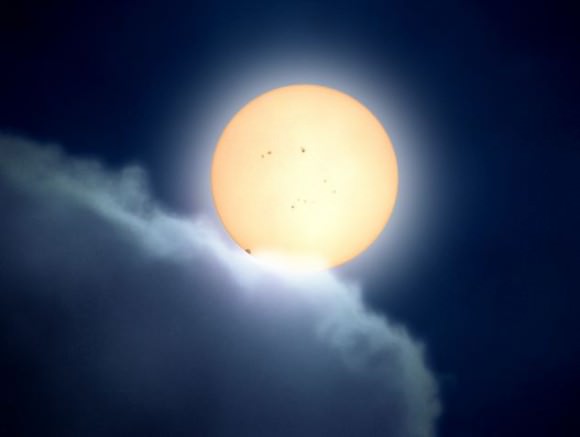
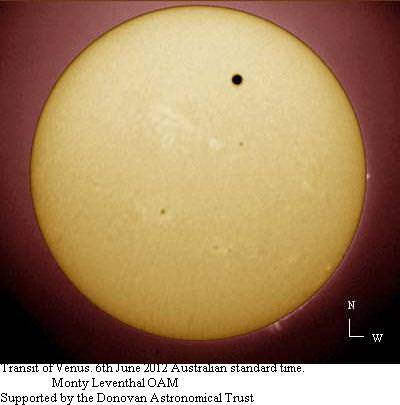
Renowned amateur astrophotographer Monthy Leventhal from Australia sent us this ‘digital filtergram’ of the Venus. He said seeing conditions were poor, as it was very cloudy, with showers, but he still managed a great shot. Camera: Canon 600D, Filter: H-alpha 6Å, Telescope: Solaris.
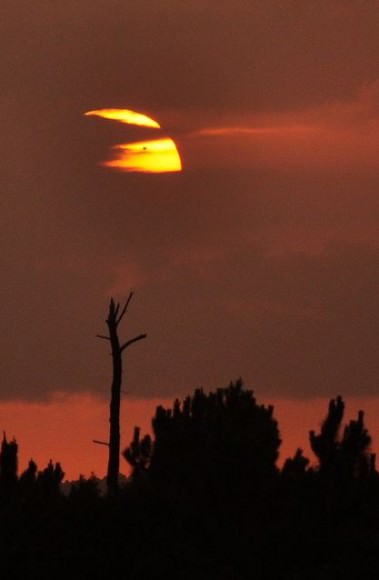
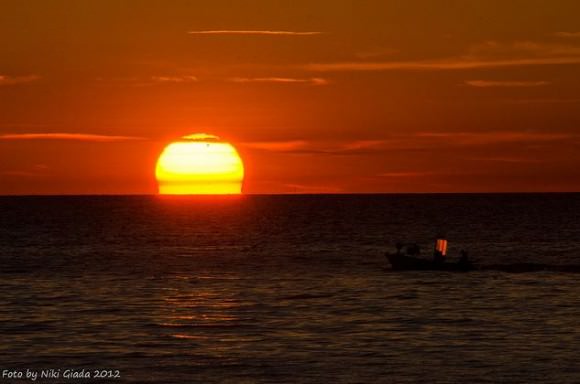
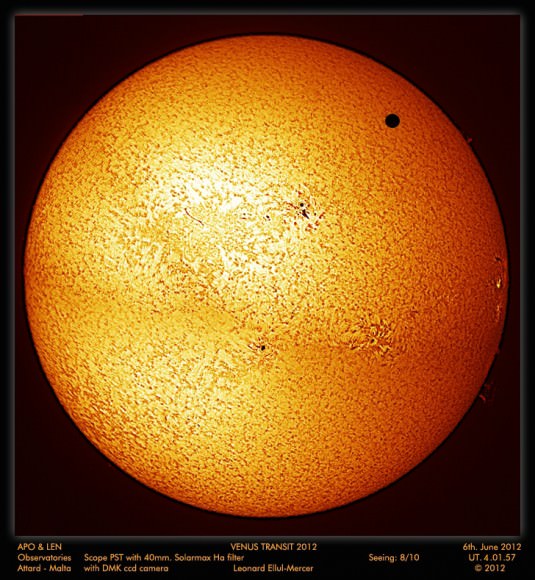
Leonard E. Mercer from Malta wrote us, “Here is one of my images taken today at 6.01.57 local time (UT.04.01.57). The conditions were very favourable. I didn’t expect such sharpness considering the sun was so low. From our region we could only view the end of the transit. But still I am very happy with the resulting image.”
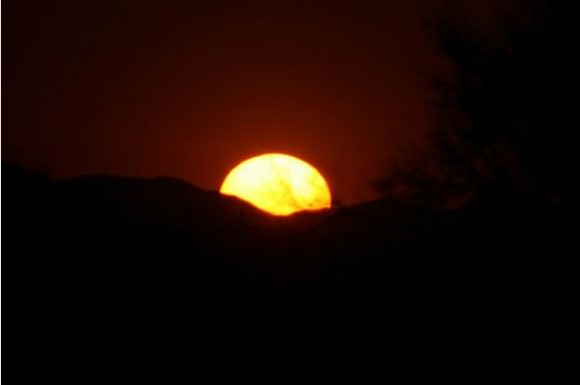
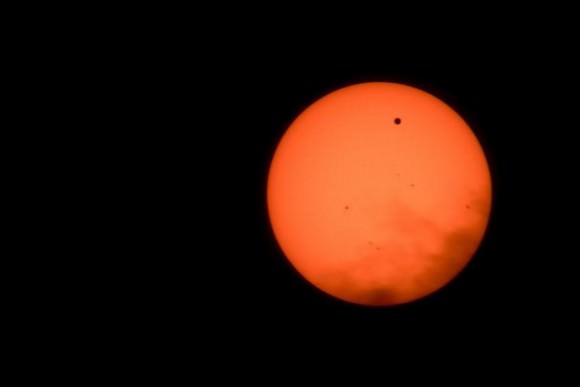
This one from Dave Griffith in Canada, who said, “Made at 6:05 PM with a Pentax K-r, a Takumar-A 2x tele-converter, a Sigma 100-300mm 1:4.5-6.7 DL lens, and a solar filter made from a sheet of Seymour Solar Optical Thin Film. The image was made on the side of Highway 63 between Fort McMurray and Edmonton. This was taken at ISO 100 with an aperture of f/11 and an equivalent focal length of 900mm. A brief tale about how I lucked out in even seeing the sun today is posted here.
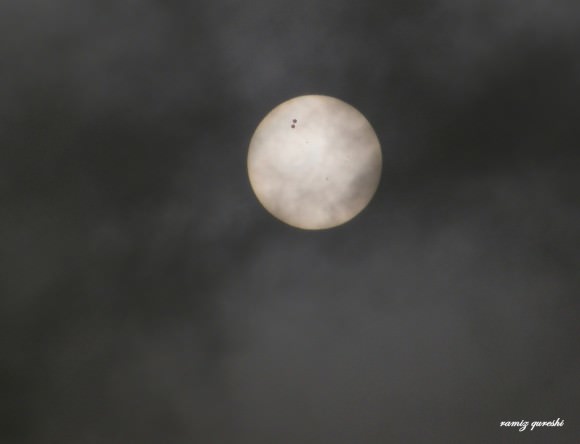
Ramiz Qureshi from Pakistan wrote to tell Universe Today, “We were badly clouded out here in Karachi, Pakistan for the past 2 days. In an awesome coincidence, the clouds stayed still on the morning of transit, doubling as an atmospheric filter. This allowed us to observe the Sun plainly with our naked eyes as it rose with the transit already in progress.” Qureshi added that the two silhouettes actually is a composite/overlap of two shots taken an hour apart.
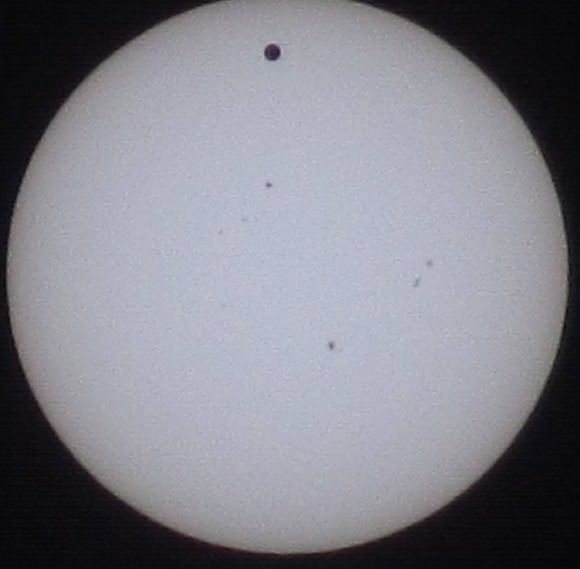
Saeed Amiri from Tehran, Iran took this image at 8:12 AM local time using a Canon PowerShot SX210 with Focal length: 70 mm, Exposure time: 1/640 sec, ISO: 100
F-stop: f/5.9, Filter: Mylar.
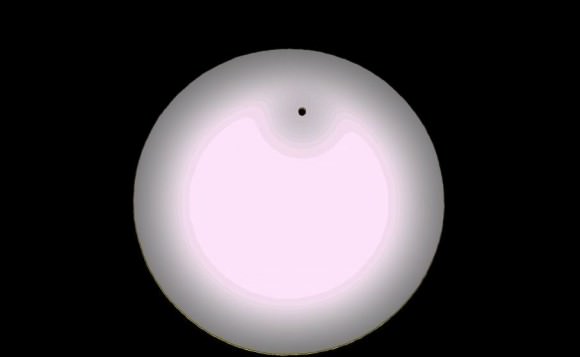
Jukka Seppälä from Finland wrote to show us his artistic views of the Venus transit. “I have tried to get some kind of artistic impression by manipulating photos with extreme exposure, contrast, brightness levels etc.”
Patrick Cullis provided this video of an airliner joining in on the transit action:
https://vimeo.com/43523342
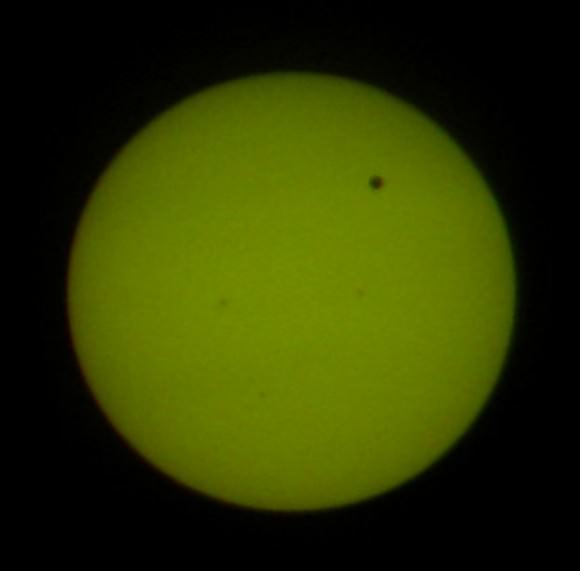
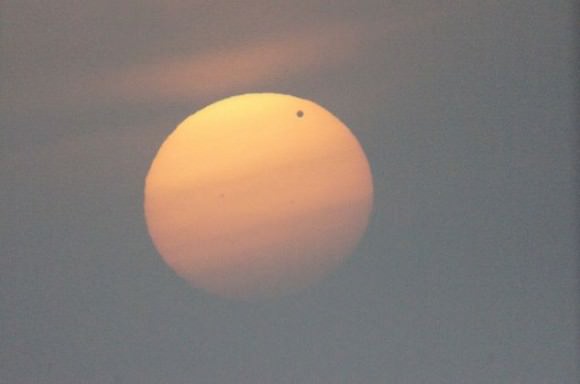
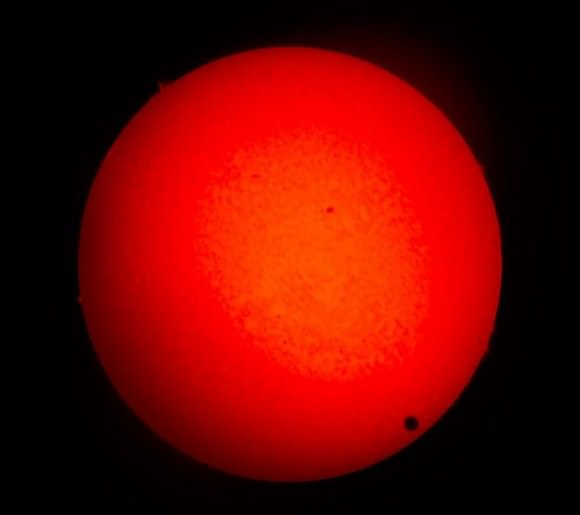
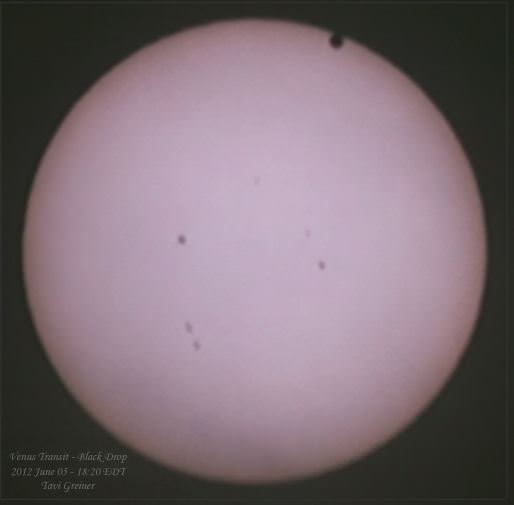
Another phenomenon observed during the transit included the ‘black drop’ effect – the small black teardrop shape that appears to connect Venus to the limb of the Sun just after it has fully entered the solar disc and again later, when it begins to leave the disc. Tavi Greiner captured it!
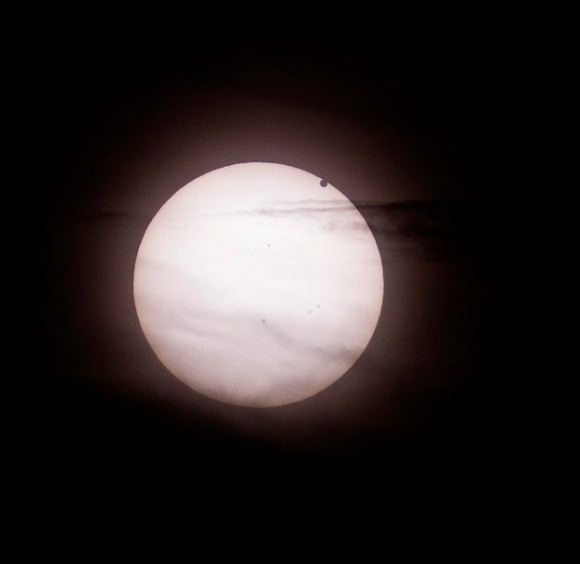
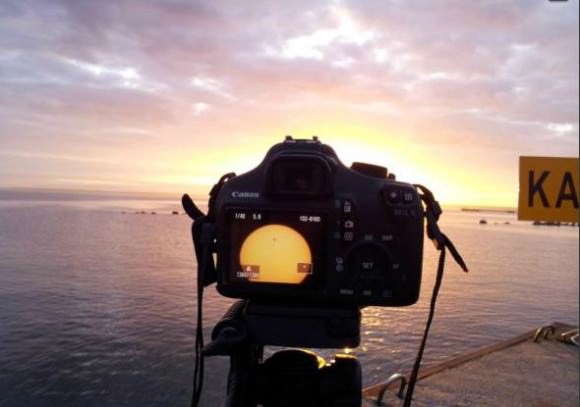
Thanks to everyone who sent in images or posted them to our Flickr page. As always, you can see more great images at our pool page on Flickr.
Weekly SkyWatcher’s Forecast: June 4-10, 2012

[/caption]
Greeting, fellow SkyWatchers! It’s gonna’ be a great week! We start off with a partial lunar eclipse of the Strawberry Moon, head into the historic Venus Transit, study some Herschel objects, catch both the Scorpid and Arietid Meteor Showers, practice some binocular astronomy and even take on some challenge objects! How awesome is that? Whenever you’re ready, just follow me into the back yard…
Monday, June 4 – Tonight the Moon is full. Often referred to as the Full Strawberry Moon, this name was a constant to every Algonquin tribe in North America. But, our friends in Europe referred to it as the Rose Moon. The North American version came about because the short season for harvesting strawberries comes each year during the month of June – so the full Moon that occurs during that month was named for this tasty red fruit!
This evening as the Sun sets and the Moon rises opposite of it, take advantage of some quiet time and really stop to look at the eastern horizon. If you are lucky enough to have clear skies, you will see the Earth’s shadow rising – like a dark, sometimes blue band – that stretches around 180 degrees of horizon. Look just above it for a Rayleigh scattering effect known as the “Belt of Venus”. This beautiful pinkish glow is caused by the backscattering of sunlight and is often referred to as the anti-twilight arch. As the Sun continues to set, this boundary between our shadow and the arch rises higher in the sky and gently blends with the coming night. What you are seeing is the shadow of the Earth’s translucent atmosphere, casting a shadow back upon itself. This happens every night! Pretty cool, huh?
For some of us, it’s eclipse time! According to NASA’s Fred Espenak, most of the Americas will experience moonset before the partial lunar eclipse ends while eastern Asia will miss the beginning of the eclipse because it occurs before moonrise. The Moon’s contact times with Earth’s shadows are: Penumbral Eclipse Begins: 08:48:09 UT, Partial Eclipse Begins: 09:59:53 UT, Greatest Eclipse: 11:03:13 UT, Partial Eclipse Ends: 12:06:30 UT, Penumbral Eclipse Ends: 13:18:17. At the instant of greatest eclipse the umbral eclipse magnitude will reach 0.3705. At that time the Moon will be at the zenith for observers in the South Pacific. In spite of the fact that just a third of the Moon enters the umbral shadow (the Moon’s southern limb dips 12.3 arc-minutes into the umbra) the partial phase still lasts over 2 hours. Be sure to visit the resource pages for a visibility map and links to precise times and locations!
Tuesday, June 5 – Heads up for all observers! Today’s universal date marks an historic event – Venus will transit the Sun! This event will cross international date lines, so be sure to know ahead of time when and where to watch. North America will be able to see the start of the transit, while South Asia, the Middle East, and most of Europe will catch the end of it. For some great information on when, where and how to watch, visit www.transitofvenus.org. If you’re clouded out, there’s plenty of resources on-line to view this rare event. One that promises to have plenty of extra bandwidth to serve visitors is Astronomy Live. Be there!!
For all you Stargazers, keep watch for the Scorpid meteor shower. Its radiant will be near the constellation of Ophiuchus, and the average fall rate will be about 20 per hour with some fireballs.
While you’re out, take the time to check out Alpha Herculis -Ras Algethi. You will find it not only to be an interesting variable, but a colorful double as well. The primary star is one of the largest known red giants and at about 430 light years away, it is also one of the coolest. Its 5.4 magnitude greenish companion star is easily separated in even small scopes – but even it is a binary! This entire star system is enclosed in an expanding gaseous shell that originates from the evolving red giant. Enjoy it tonight.
Wednesday, June 6 – So far we’ve studied many Herschel objects in disguise as Messier catalog items – but we haven’t really focused on some mighty fine galaxies that are within the power of the intermediate to large telescope. Tonight let’s take a serious skywalk as we head to 6 Comae and drop two degrees south.
At magnitude 10.9, Herschel catalog object H I.35 is also known by its New General Catalog number of 4216 (Right Ascension: 12 : 15.9 – Declination: +13 : 09). This splendid edge-on galaxy has a bright nucleus and will walk right out in larger telescopes with no aversion required. But, the most fascinating part about studying anything in the Virgo cluster is about to be revealed.
While studying structure in NGC 4216, averted vision picks up magnitude 12 NGC 4206 (Right Ascension:12 : 15.3 – Declination: +13 : 02) to the south. This is also a Herschel object – H II.135. While it is smaller and fainter, the nucleus will be the first thing to catch your attention – and then you’ll notice it is also an edge-on galaxy! As if this weren’t distracting enough, while re-centering NGC 4216, sometimes the movement is just enough to allow the viewer to catch yet another edge-on galaxy to the north – NGC 4222 (Right Ascension: 12 : 16.4 – Declination: +13 : 19). At magnitude 14, you can only expect to be able to see it in larger scopes, but what a treat this trio is!
Is there a connection between certain types of galaxy structures within the Virgo cluster? Science certainly seems to think so. While low metallicity studies involving these galaxies are going on, research into evolution of galaxy clusters themselves continue to make new strides forward in our understanding of the universe. Capture them tonight!
Thursday, June 7 – If you’re up before dawn the next two days or out just after sunset, enjoy the peak of the June Arietid meteors – the year’s strongest daylight shower – with up to 30 visible per hour.
If you’d like to try your ear at radio astronomy with the offspring of sungrazing asteroid Icarus, tune an FM radio to the lowest frequency not receiving a clear signal. An outdoor antenna pointed at the zenith increases your chances, but even a car radio can pick up strong bursts! Simply turn up the static and listen. Those hums, whistles, beeps, bongs, and occasional snatches of signals are our own radio signals being reflected off the meteor’s ion trail!
Tonight let’s study a radio-source galaxy so bright it can be seen in binoculars – 8.6 magnitude M87 (Right Ascension: 12 : 30.8 – Declination: +12 : 24), about two fingerwidths northwest of Rho Virginis. This giant elliptical was discovered by Charles Messier in 1781 and cataloged as M87. Spanning 120,000 light-years, it’s an incredibly luminous galaxy containing far more mass and stars than the Milky Way – gravitationally distorting its four dwarf satellites galaxies. M87 is known to contain in excess of several thousand globular clusters – up to 150,000 – and far more than our own 200.
In 1918, H. D. Curtis of Lick Observatory discovered something else – M87 has a jet of gaseous material extending from its core and pushing out several thousand light-years into space. This highly perturbed jet exhibits the same polarization as synchrotron radiation – a property of neutron stars. Containing a series of small knots and clouds as observed by Halton Arp at Palomar in 1977, he also discovered a second jet in 1966 erupting in the opposite direction. Thanks to these two properties, M87 made Arp’s “Catalog of Peculiar Galaxies” as number 152.
In 1954 Walter Baade and R. Minkowski identified M87 with radio source Virgo A, discovering a weaker halo in 1956. Its position over an x-ray cloud extending through the Virgo cluster make M87 a source of an incredible amount of x-rays. Because of its many strange properties, M87 remains a target of scientific investigation. The Hubble has shown a violent nucleus surrounded by a fast rotating accretion disc, whose gaseous make-up may be part of a huge system of interstellar matter. As of today, only one supernova event has been recorded – yet M87 remains one of the most active and highly prized study galaxies of all. Capture it tonight!
Friday, June 8 – Born on this date in 1625 was Giovanni Cassini – the most notable observer following Galileo. As head of the Paris Observatory for many years, he was the first to observe seasonal changes on Mars and measure its parallax (and so, its distance). This set the scale of the solar system for the first time. Cassini was the first to describe Jovian features, and studied the Galilean moons’ orbits. He also discovered four moons of Saturn, but he is best remembered for being the first to see the namesake division between the A and B rings.
Why not honor Cassini’s work by visiting Saturn tonight? In case you hadn’t noticed, the beautiful yellowish “star” has been on the move and is now around a degree away to the southeast from a previous study star – Porrima! Not only is this a lovely visual, but an easy way to find Saturn if you’re new to the game. Seeing the Cassini Division in Saturn’s ring structure and some of the smaller moons will require at least a 114mm telescope and steady seeing. Use as much magnification as conditions will allow and look for unusual things – like seeing the planet edge through the gap!
Tonight we’ll use Rho Virginis as a stepping stone to more galaxies. Get on your mark and move one and a half degrees north for M59 (Right Ascension:12 : 42.0 – Declination: +11 : 39)…
First discovered in 1779 by J. G. Koehler while studying a comet, this 11th magnitude elliptical galaxy was observed and labeled by Messier who was just a bit behind him. Much denser than our own galaxy, M59 is only about one-fourth the size of the Milky Way. In a smaller telescope, it will appear as a faint oval, while larger telescopes will make out a more concentrated core region.
Now shift one half degree east for brighter and larger M60. Also caught first by Koehler on the same night as M59, it was “discovered” a day later by yet another astronomer who had missed M59! It took Charles Messier another four days until this 10th magnitude galaxy interfered with his comet studies and was cataloged. At around 60 million light-years away, M59 is one of the largest ellipticals known and has five times more mass than our galaxy. As a study object of the Hubble Telescope, this giant has shown a concentrated core with over 2 billion solar masses. Photographed and studied by large terrestrial telescopes, M59 may contain as many as 5100 globular clusters in its halo.
While our backyard equipment is essentially revealing M59?s core, there is a curiosity here. It shares “space” with spiral galaxy NGC 4647 (Right Ascension: 12 : 43.5 – Declination: +11 : 35). Telescopes of even modest aperture will pick up the nucleus and faint structure of this small face-on galaxy. Harlow Shapely found the pair odd because – while they are relatively close in astronomical terms – they are very different in age and development. Halton Arp also studied this combination of an elliptical galaxy affecting a spiral and cataloged it as “Peculiar Galaxy 116.” Be sure to mark your notes!
Saturday, June 9 – Today is the birthday of Johann Gottfried Galle. Born in Germany in 1812, Galle was the first observer to locate Neptune. He is also known for being Encke’s assistant – and he’s one of the few astronomers ever to have observed Halley’s Comet twice. Unfortunately, he died two months after the comet passed perihelion in 1910, but at a ripe old age of 98! I wonder if he knew Mark Twain?
Tonight while we’re out, let’s have a look at a Virgo galaxy bright enough for smaller instruments and detailed enough to delight larger scopes. Starting at Delta Virginis, move about a fistwidth to the west where you will see two fainter stars, 16 (south) and 17 (north) Virginis. You’ll find M61 (Right Ascension:12 : 21.9 – Declination: +04 : 28) located about one-half degree south of the yellow double star 17.
Its discovery was credited to Barnabus Oriani during that fateful year of 1779 when Messier was so avid about chasing a comet that he mistook it for one. While Charles had seen it on the same night, it took him two days to figure out it wasn’t moving and four more before he cataloged it. Fortunately, 7 years later Mr. Herschel assigned it his own number of H I.139, even though he wasn’t fond of assigning his own number to Messier catalog objects.
At near 10th magnitude, this spiral galaxy will show a slightly elongated form and brighter core area to small telescopes, and really come to life in larger ones. Close to our own Milky Way galaxy in size, this larger member of the Virgo cluster has great spiral arm structure that displays both knots and dark dustlanes – as well as a beautifully developed nucleus region. M61 has also been host to four supernova events between 1926 and 1999 – all of which have been well within range of amateur telescopes.
For an added Herschel treat tonight for larger scopes, hop back to star 17 and head about one half degree due west for near galactic pair NGC 4281 (H II.573) and NGC 4273 (H II.569). Here is a study of two galaxies similar in magnitude (12) and size – but of different structure. Northeastern NGC 4281 (Right Ascension: 12 : 20.4 – Declination: +05 : 23) is an elliptical, and by virtue of its central concentration will appear slightly larger and brighter – while southwestern NGC 4273 (Right Ascension: 12 : 19.9 – Declination: +05 : 21) is an irregular spiral which will appear brighter in the middle but more elongated and faded along its frontiers. Sharp-eyed observers may also note fainter (13th magnitude) NGC 4270 (Right Ascension: 12 : 19.8 – Declination: +05 : 28) north of this pairing.
Now, go back to Rho once again and about a fingerwidth northwest for yet another bright galaxy – M58 – a spiral galaxy actually discovered by Messier in 1779! As one of the brightest galaxies in the Virgo cluster, M58 (Right Ascension: 12 : 37.7 – Declination: +11 : 49) is one of only four that have barred structure. It was cataloged by Lord Rosse as a spiral in 1850. In binoculars, it will look much like our previously studied ellipticals, but a small telescope under good conditions will pick up the bright nucleus and a faint halo of structure – while larger ones will see the central concentration of the bar across the core. Chalk up another Messier study for both binoculars and telescopes and let’s get on to something really cool!
Around a half degree southwest are NGC 4567 (Right Ascension: 12 : 36.5 – Declination: +11 : 15) and NGC 4569 (Right Ascension: 12 : 36.8 – Declination: +13 : 10). L. S. Copeland dubbed them the “Siamese Twins,” but this galaxy pair is also considered part of the Virgo cluster. While seen from our viewpoint as touching galaxies, no evidence exists of tidal filaments or distortions in structure, making them a line of sight phenomenon and not interacting members. While that might take little of the excitement away from the “Twins,” a supernova event has been spotted in NGC 4569 as recently as 2004. While the duo is visible in smaller scopes as two, with soft twin nuclei, intermediate and larger scopes will see an almost V-shaped or heart-shaped pattern where the structures overlap. If you’re doing double galaxy studies, this is a fine, bright one! If you see a faint galaxy in the field as well, be sure to add NGC 4564 (Right Ascension: 12 : 36.4 – Declination: +11 : 26) to your notes.
Sunday, June 10 – While I’m sure that unaided eye viewers and binocular users are tired of the galaxy hunt, be sure to take the time to look at many old favorites that are now in view. To the eye, one of the most splendid signs of the changing seasons is the Ursa Major Moving Group which sits above Polaris for northern hemisphere observers. For the southern hemisphere, the return of Crux serves the same purpose.
Old favorites have now begun to appear again, such as Hercules, Cygnus and Scorpius… and with them a wealth of starry clusters and nebulae that will soon come into view as the night deepens and the hour grows late. Before we leave Virgo for the year, there is one last object that is seldom explored and such a worthy target that we must visit it before we go. Its name is NGC 5634 and you’ll find it halfway between Iota and Mu Virginis (RA 14 29.37 Dec -05 58.35)…First discovered by Sir William Herschel on March 5, 1785 and cataloged as H I.70, this magnitude 9.5 small globular cluster isn’t for everyone, but thanks to an 11th magnitude line-of-sight star on its eastern edge, it sure is interesting. At class IV, it’s more concentrated than many globular clusters, although its 19th magnitude members make it near impossible to resolve with backyard equipment.
Located a bit more than 82,000 light-years from our solar system and about 69,000 light-years from the galactic center, you’ll truly enjoy this globular for the randomly scattered stellar field which accompanies it. In the finderscope, an 8th magnitude star will lead the way – not truly a member of the cluster, but one that lies between us. Capturable in scopes as small as 4.5?, look for a concentrated central area surrounded by a haze of stellar members – a huge number of which are recently discovered variables. While you look at this globular, keep this in mind… Based on observations with the Italian Telescopio Nazionale Galileo, it is now surmised that the NGC 5634 globular cluster has the same position and radial velocity as does the Sagittarius dwarf spheroidal galaxy. Because of the dwarf galaxy’s metal-poor population of stars, it is believed that NGC 5634 may have once been part of the dwarf galaxy – and been pulled away by our own tidal field to become part of the Sagittarius stream!
Until next week? Wishing you clear skies for the Partial Lunar Eclipse, Venus Transit and the meteor showers!
Help Astronomers Collect Venus Transit Data!
[/caption]During June 5th/6th 2012, Venus will be transiting the Sun, where it will make a rare appearance as a small dot moving across the face of the Sun. Astronomers around the world are planning observations, and one team is traveling to Easter Island in an attempt to reproduce the measurements first made/proposed by Edmund Halley in the late 1600’s, getting precise data of first contact between Venus and the Sun. They are working with students from around the world and are looking for help to connect with more students to participate in the event.
The team is asking for assistance from astronomy clubs and organizations, especially those who work with school children. Since the team will be observing on Easter Island, their view of the transit will be limited (it begins two hours before sunset). Since the team will only be measuring the time of ingress and not egress, the team is reaching out to additional observers to help collect data. So far, the team has colleagues in Hawaii, New York, Australia, Iran, and Holland who will be assisting with their efforts.
Keep reading to learn how your club (or school group) can help collect transit data!
Dr. Jacqueline Faherty states, “As part of the celebration, we are networking multiple school groups around the world that are also viewing the transit so we can make a measurement of the distance to the Sun, combining timing measurements of first and last contact from various points on the Earth.” Faherty also adds, “This is not about making an accurate measurement but rather an attempt to inspire young students, our next generation of scientists, when they see that astronomical phenomena (while rare) can be used to make real and extremely useful measurements while at the same time connecting a network of students from different countries, cultures, political histories, etc.”
To participate you only need do the following:
Once again the team is especially interested in school groups that will be viewing the transit. The team hopes to inspire the next generation of scientists, by demonstrating how astronomical phenomenon can be used for scientific purposes. The team will feature photos from participating groups and the results of their measurements in a blog series hosted by the American Museum of Natural History.
For more information on the team, visit their website at: http://www.das.uchile.cl/~drodrigu/easter/index_en.html
If you’d like to see the math behind the measurements, visit David Rodriguez’s blog: http://strakul.blogspot.com/2012/05/measuring-distance-to-sun-with-transit.html
Visibility information for the transit of Venus can be found at: http://eclipse.gsfc.nasa.gov/OH/transit12.html.
Source: Dr. Catherine Kaleida, Dr. Jacqueline Faherty, and the 2012 Transit of Venus Easter Island Public Outreach Team
Transit
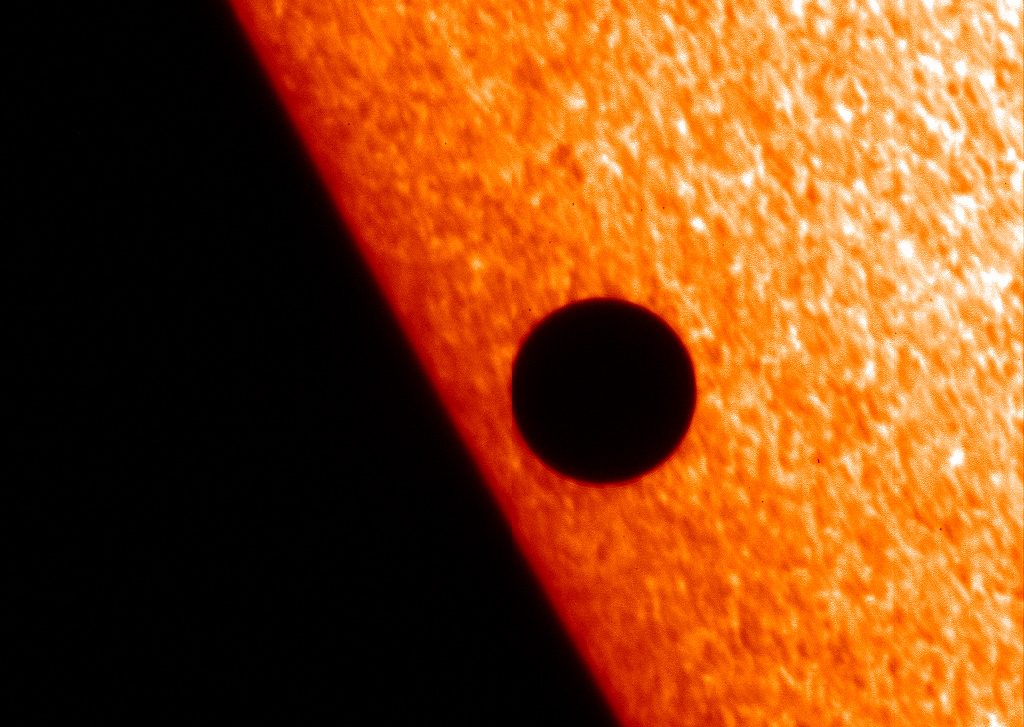
[/caption]
Although the word “transit” can have many meanings, here on Universe Today, we’re talking about astronomical transits. This is where one object in space moves directly in front of another, partly obscuring it from view.
The most famous example of an astronomical transit is a solar eclipse. From our vantage point on Earth, the Moon appears to pass directly in front of the Sun, obscuring it, and darkening the sky. When seen from space, the Moon casts a shadow on the surface of the Earth; only people within that shadowed area actually see the transit.
In order to have a transit, you need to have a closer object, a more distant object, and then an observer. When all three objects are lined up in a straight line, you’ll get a transit. There can be transits of Mercury and Venus across the surface of the Sun, or a transit of Earth across the Sun, seen from Jupiter. We can also see the transit of moons across the surface of their planets. Jupiter often has moons transiting in front of it.
Astronomers use the transit technique to discover extrasolar planets orbiting other stars. When a planet passes in front of a star, it dims the light from the star slightly. And then the star brightens again as the planet moves away. By carefully measuring the brightness of the star, astronomers are able to detect if they have planets orbiting them.
Transits are also helpful for studying the atmospheres of objects in the Solar System. Astronomers discovered that Pluto has a tenuous atmosphere by studying how it dimmed the light from a more distant star. As Pluto began transiting in front of the star, its atmosphere partly obscured the star, changing the amount of light observed. Astronomers were then able to work out the chemicals in Pluto’s atmosphere.
The next transit of Mercury will occur in 2016, and the next transit of Venus is scheduled to occur in 2012.
We have written many articles about astronomical transit for Universe Today. Here’s an article about the transit of Mercury, and here’s an article about the transit of Venus.
If you’d like more info about Astronomical Transit, check out NASA Homepage, and here’s a link to NASA’s Solar System Simulator.
We’ve also recorded related episodes of Astronomy Cast about the Eclipse. Listen here, Episode 160: Eclipses.
Source: Wikipedia

